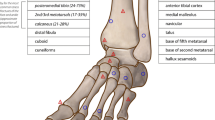Summary
This by anamnesis and X-ray-series exactly documented accident producing bimalleolar luxationfracture, is followed by growing of gigantic bonetumor in the regional sceletonelements of a 59 aged femal patient. The published casuistic situation belonging to the pathological problem of posttraumatic tumorgenesis in bonetissue seems to be of special interest, because there is a big difference between the expansive clinical development with obligate indication of legamputation and the non-malicious histopathological finding with the appearance of gigantic cell tumor.
Résumé
Cette accident documentée dans le radiogramme et dans l'anamnese est diagnostiquée comme fracture-luxation bimalleolaire et fait voir une coincidence temporaire avec le commencement de la croissance et la formation d'un tumeur géant dans la sphère du squelette locale d'une malade à l'âge de 59. La contribution casuistique présentée du problème de la genèse des tumeurs posttraumatiques dans le tissu osseux est très intéressante à cause de la suite expansive et clinique avec l'indication d'amputation qui est en contraire aux états histopathologiques, ne pas malignes avec l'apparence des tumeurs aux cellules géantes.
Zusammenfassung
Dieser anamnestisch und röntgenologisch exakt dokumentierte Unfall mit bimalleolärer Luxationsfraktur hat zeitliche Koincidenz mit dem Wachstumsbeginn gigantischer Tumorbildung im lokalen Skeletbereich bei einer 59jährigen Patientin. Der vorliegende kasuistische Beitrag zur Problematik posttraumatischer Tumorgenese im Knochengewebe ist deshalb besonders interessant, weil der expansive klinische Verlauf mit zwingender Amputationsindikation einem nichtmalignen histopathologischen Befund mit Riesenzellgeschwulstcharakter gegenübersteht.
Similar content being viewed by others
Literatur
Bauer, K. H.: Über den Zusammenhang zwischen malignen Tumoren und Unfällen bzw. Berufsschäden. Mschr. Unfallheilk. 43, 76–93 (1952).
—— Das Krebsproblem, 2. Aufl. Berlin-Göttingen-Heidelberg: Springer 1949.
—— Frey, R.: Geschwulst und Traumen. Hdb. der Unfallheilk., Bd. 2. Stuttgart: Enke 1955.
Hetzler, H. J.: Weichteilsarkom und Trauma in der Unfallbegutachtung. Vorträge prakt. Chirurgie, Bd. 67. Stuttgart: Enke 1964.
Dietrich, A.: Geschwulstbildung durch äußere Einwirkungen. Mschr. Unfallheilk. 57, 1–11 (1954).
Eger, H.: Zur Frage der Geschwulstentstehung durch chronisches Trauma. Z. ärztl. Fortbild. 56, 188–190 (1962).
Flemming, F.: Oberschenkelstumpfsarkom als späte Traumafolge. Mschr. Unfallheilk. 69, 252–255 (1966).
Frey, R.: Statistische Gesetzmäßigkeiten beim Auftreten der Sarkome. Langenbecks Arch. klin. Chir. 263, 1–13 (1949).
Greinemann, H.: Spindelzellsarkom nach Vorfußprellung. Mschr. Unfallheilk. 69, 192 (1966).
Gschnitzer, F.: Gemmangiom nach Trauma. Mschr. Unfallheilk. 68, 494–504 (1965).
Haslhofer, L.: Gutartige Riesenzelltumoren der Knochen und sog. Knochenzysten. Hdb. der spez. Pathologie und Histologie, Bd. IX, Teil 3. Berlin: Springer 1937.
Hellner, H.: Aus Unfallakten: Knochensarkom, als mittelbare Unfallfolge anerkannt. Mschr. Unfallheilk. 68, 101–104 (1965).
—— Semimaligne Geschwülste. Arch. Geschwulstforsch. 18, 107–119 (1961).
—— Poppe, H.: Röntgenologische Differentialdiagnose der Knochenerkrankungen. Stuttgart: Thieme 1956.
Herzog, G.: Die primären Knochengeschwülste. In: Hdb. der spez. pathologischen Anatomie und Histologie von R. Rössle, Bd. IX, 5. Teil, S. 151 ff. Berlin: Springer 1944.
Jantschew, W. G., Kolew, P., Jordanow, E., Natschew, T., Ptaschnikowa, D.: Über den ursächlichen Zusammenhang zwischen Trauma und Osteosarkom. Z. ges. inn. Med. 18, 308–316 (1963).
Konjetzny, G. E.: Zur Beurteilung der gutartigen Riesenzellgeschwülste der Knochen. Chirurg 7, 245–252 (1937).
—— Sog. lokalisierte Ostitis fibrosa und Trauma. Mschr. Unfallheilk. 46, 572–579 (1939).
Lubarsch, O.: Geschwülste und Unfall. Verh. 3. internat. Unfallkongreß in Düsseldorf 1912.
Pommer, G.: Zur Kenntnis der progressiven Hämatom- und Phlegmasieveränderungen der Röhrenknochen auf Grund der mikroskopischen Befunde im neuen Knochenzystenfall H. v. Haberers. Arch. orthop. Unfall-Chir. 17, 17 (1920).
Schinz, H. R., Baensch, W. E., Friedl, E., Uehlinger, E.: Lehrbuch der Röntgendiagnostik, Bd. I, Teil 1, S. 853–862, 5 Aufl. Stuttgart: Thieme 1952.
Schmidt, M. B.: Trauma und Geschwulstbildung. Z. Krebsforsch. 47, 91–107 (1938).
Author information
Authors and Affiliations
Additional information
Herrn Professor Dr. med. Drs. h. c. Georg Hohmann zum 90. Geburtstag am 28. 2. 1970.
Rights and permissions
About this article
Cite this article
Bernbeck, R., Lotze, M. Zur Problematik posttraumatischer Knochentumorgenese. Arch orthop Unfall-Chir 68, 132–151 (1970). https://doi.org/10.1007/BF00416716
Received:
Issue Date:
DOI: https://doi.org/10.1007/BF00416716




